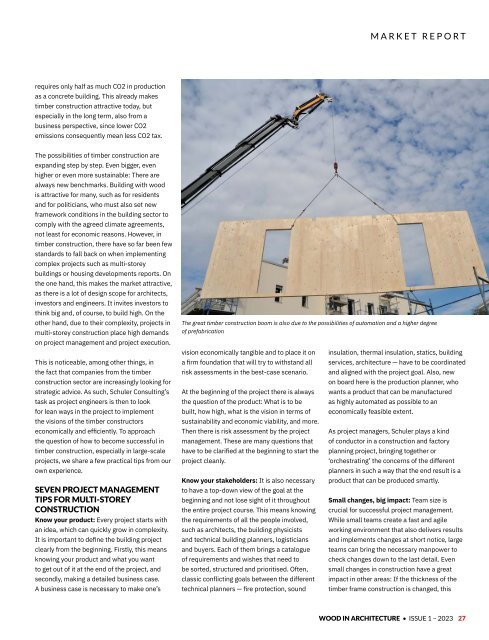Wood In Architecture Issue 1, 2023
First published in 2017, Wood in Architecture (WIA) is a bi-annual trade magazine devoted to the international timber construction sector. The newest addition to the Panels & Furniture Group of wood magazines, WIA features in-depth insights to the latest industry news, incredible projects and leading trade events. WIA is an advocate for timber as a material of choice for today’s built environment, and is the perfect source of inspiration for architects, builders, engineers and interior designers across the globe.
First published in 2017, Wood in Architecture (WIA) is a bi-annual trade magazine devoted to the international timber construction sector. The newest addition to the Panels & Furniture Group of wood magazines, WIA features in-depth insights to the latest industry news, incredible projects and leading trade events. WIA is an advocate for timber as a material of choice for today’s built environment, and is the perfect source of inspiration for architects, builders, engineers and interior designers across the globe.
- No tags were found...
You also want an ePaper? Increase the reach of your titles
YUMPU automatically turns print PDFs into web optimized ePapers that Google loves.
MARKET REPORT<br />
requires only half as much CO2 in production<br />
as a concrete building. This already makes<br />
timber construction attractive today, but<br />
especially in the long term, also from a<br />
business perspective, since lower CO2<br />
emissions consequently mean less CO2 tax.<br />
The possibilities of timber construction are<br />
expanding step by step. Even bigger, even<br />
higher or even more sustainable: There are<br />
always new benchmarks. Building with wood<br />
is attractive for many, such as for residents<br />
and for politicians, who must also set new<br />
framework conditions in the building sector to<br />
comply with the agreed climate agreements,<br />
not least for economic reasons. However, in<br />
timber construction, there have so far been few<br />
standards to fall back on when implementing<br />
complex projects such as multi-storey<br />
buildings or housing developments reports. On<br />
the one hand, this makes the market attractive,<br />
as there is a lot of design scope for architects,<br />
investors and engineers. It invites investors to<br />
think big and, of course, to build high. On the<br />
other hand, due to their complexity, projects in<br />
multi-storey construction place high demands<br />
on project management and project execution.<br />
This is noticeable, among other things, in<br />
the fact that companies from the timber<br />
construction sector are increasingly looking for<br />
strategic advice. As such, Schuler Consulting’s<br />
task as project engineers is then to look<br />
for lean ways in the project to implement<br />
the visions of the timber constructors<br />
economically and efficiently. To approach<br />
the question of how to become successful in<br />
timber construction, especially in large-scale<br />
projects, we share a few practical tips from our<br />
own experience.<br />
SEVEN PROJECT MANAGEMENT<br />
TIPS FOR MULTI-STOREY<br />
CONSTRUCTION<br />
Know your product: Every project starts with<br />
an idea, which can quickly grow in complexity.<br />
It is important to define the building project<br />
clearly from the beginning. Firstly, this means<br />
knowing your product and what you want<br />
to get out of it at the end of the project, and<br />
secondly, making a detailed business case.<br />
A business case is necessary to make one’s<br />
The great timber construction boom is also due to the possibilities of automation and a higher degree<br />
of prefabrication<br />
vision economically tangible and to place it on<br />
a firm foundation that will try to withstand all<br />
risk assessments in the best-case scenario.<br />
At the beginning of the project there is always<br />
the question of the product: What is to be<br />
built, how high, what is the vision in terms of<br />
sustainability and economic viability, and more.<br />
Then there is risk assessment by the project<br />
management. These are many questions that<br />
have to be clarified at the beginning to start the<br />
project cleanly.<br />
Know your stakeholders: It is also necessary<br />
to have a top-down view of the goal at the<br />
beginning and not lose sight of it throughout<br />
the entire project course. This means knowing<br />
the requirements of all the people involved,<br />
such as architects, the building physicists<br />
and technical building planners, logisticians<br />
and buyers. Each of them brings a catalogue<br />
of requirements and wishes that need to<br />
be sorted, structured and prioritised. Often,<br />
classic conflicting goals between the different<br />
technical planners — fire protection, sound<br />
insulation, thermal insulation, statics, building<br />
services, architecture — have to be coordinated<br />
and aligned with the project goal. Also, new<br />
on board here is the production planner, who<br />
wants a product that can be manufactured<br />
as highly automated as possible to an<br />
economically feasible extent.<br />
As project managers, Schuler plays a kind<br />
of conductor in a construction and factory<br />
planning project, bringing together or<br />
‘orchestrating’ the concerns of the different<br />
planners in such a way that the end result is a<br />
product that can be produced smartly.<br />
Small changes, big impact: Team size is<br />
crucial for successful project management.<br />
While small teams create a fast and agile<br />
working environment that also delivers results<br />
and implements changes at short notice, large<br />
teams can bring the necessary manpower to<br />
check changes down to the last detail. Even<br />
small changes in construction have a great<br />
impact in other areas: If the thickness of the<br />
timber frame construction is changed, this<br />
WOOD IN ARCHITECTURE • ISSUE 1 – <strong>2023</strong> 27


















